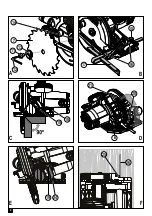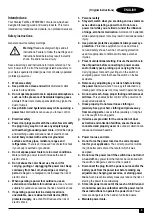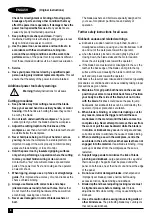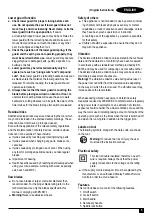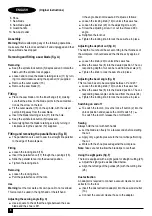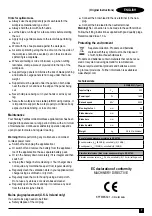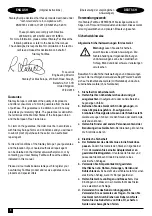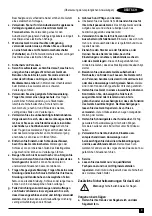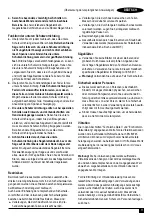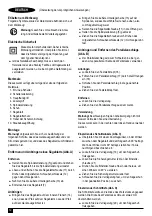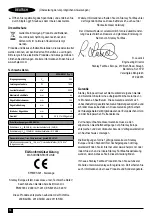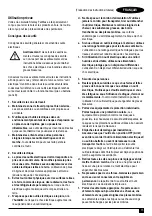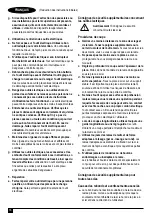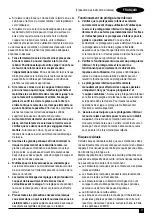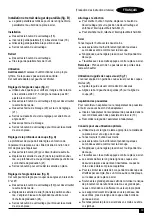
5
ENGLISH
(Original instructions)
Lower guard function
a. Check lower guard for proper closing before each
use. Do not operate the saw if lower guard does not
move freely and close instantly. Never clamp or tie the
lower guard into the open position.
If saw is
accidentally dropped, lower guard may be bent. Raise the
lower guard with the retracting handle and make sure it
moves freely and does not touch the blade or any other
part, in all angles and depths of cut.
b. Check the operation of the lower guard spring. If the
guard and the spring are not operating properly, they
must be serviced before use.
Lower guard may operate
sluggishly due to damaged parts, gummy deposits, or a
build-up of debris.
c. Lower guard may be retracted manually only for
special cuts such as "plunge cuts" and "compound
cuts".
Raise lower guard by retracting handle and as soon
as blade enters the material, the lower guard must be
released. For all other sawing, the lower guard should
operate automatically.
d. Always observe that the lower guard is covering the
blade before placing saw down on bench or floor.
An
unprotected, coasting blade will cause the saw to walk
backwards, cutting whatever is in its path. Be aware of the
time it takes for the blade to stop after switch is released.
Residual risks
Additional residual risks may arise when using the tool which
may not be included in the enclosed safety warnings. These
risks can arise from misuse, prolonged use etc.
Even with the application of the relevant safety regulations
and the implementation of safety devices, certain residual
risks can not be avoided. These include:
u
Injuries caused by touching any rotating/moving parts.
u
Injuries caused when changing any parts, blades or ac
-
cessories.
u
Injuries caused by prolonged use of a tool. When using
any tool for prolonged periods ensure you take regular
breaks.
u
Impairment of hearing.
u
Health hazards caused by breathing dust developed when
using your tool (example:- working with wood, especially
oak, beech and MDF.)
Saw blades
u
Do not use blades of larger or smaller diameter than
recommended. For the proper blade rating refer to the
technical data. Use only the blades specified in this
manual, complying with EN 847-1.
u
Warning!
Never use abrasive wheels.
Safety of others
u
This appliance is not intended for use by persons (includ-
ing children) with reduced physical, sensory or mental
capabilities, or lack of experience and knowledge, unless
they have been given supervision or instruction
concerning use of the appliance by a person responsible
for their safety.
u
Children should be supervised to ensure that they do not
play with the appliance.
Vibration
The declared vibration emission values stated in the technical
data and the declaration of conformity have been measured
in accordance with a standard test method provided by EN
60745 and may be used for comparing one tool with another.
The declared vibration emission value may also be used in a
preliminary assessment of exposure.
Warning!
The vibration emission value during actual use of
the power tool can differ from the declared value depending
on the ways in which the tool is used. The vibration level may
increase above the level stated.
When assessing vibration exposure to determine safety
measures required by 2002/44/EC to protect persons regularly
using power tools in employment, an estimation of vibration
exposure should consider, the actual conditions of use and the
way the tool is used, including taking account of all parts of the
operating cycle such as the times when the tool is switched off
and when it is running idle in addition to the trigger time.
Labels on tool
The following symbols, along with the date code, are shown
on the tool:
Warning!
To reduce the risk of injury, the user
must read the instruction manual.
Electrical safety
This tool is double insulated; therefore no earth
wire is required. Always check that the power
supply corresponds to the voltage on the rating
plate.
u
If the supply cord is damaged, it must be replaced by the
manufacturer or an authorised Stanley Fat Max Service
Centre in order to avoid a hazard.
Features
This tool includes some or all of the following features.
1. On/off switch
2. Lock-off button
3. Main handle
4. Secondary handle
5. Spindle lock button
Summary of Contents for Fat Max KFFMES301
Page 1: ...www stanley eu KFFMES301 1 7 8 9 10 2 3 5 4 6 ...
Page 2: ...2 12 11 13 7 14 A 18 19 C 6 20 21 D 19 24 E 25 26 F 15 16 17 B ...
Page 84: ...84 Tłumaczenie z oryginału w języku angielskim POLSKI ...
Page 108: ...108 Перевод инструкций РУССКИЙ ...
Page 111: ......
Page 112: ...N602909 REV 0 06 2018 ...


